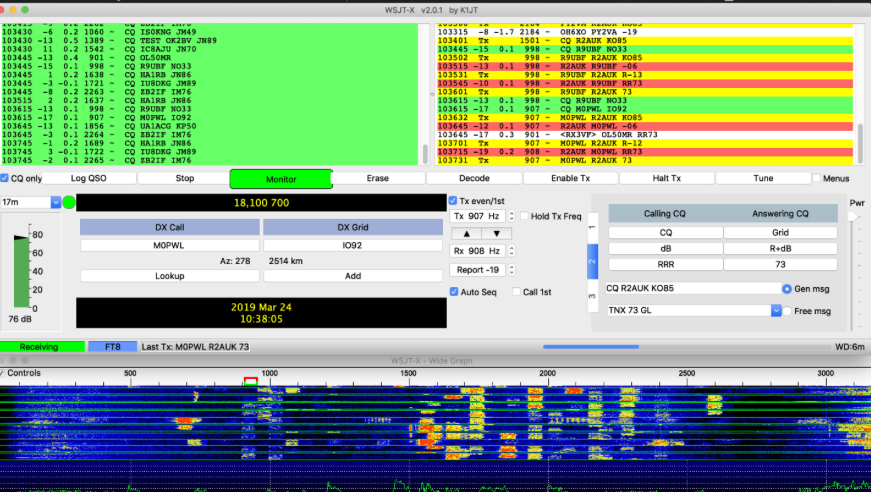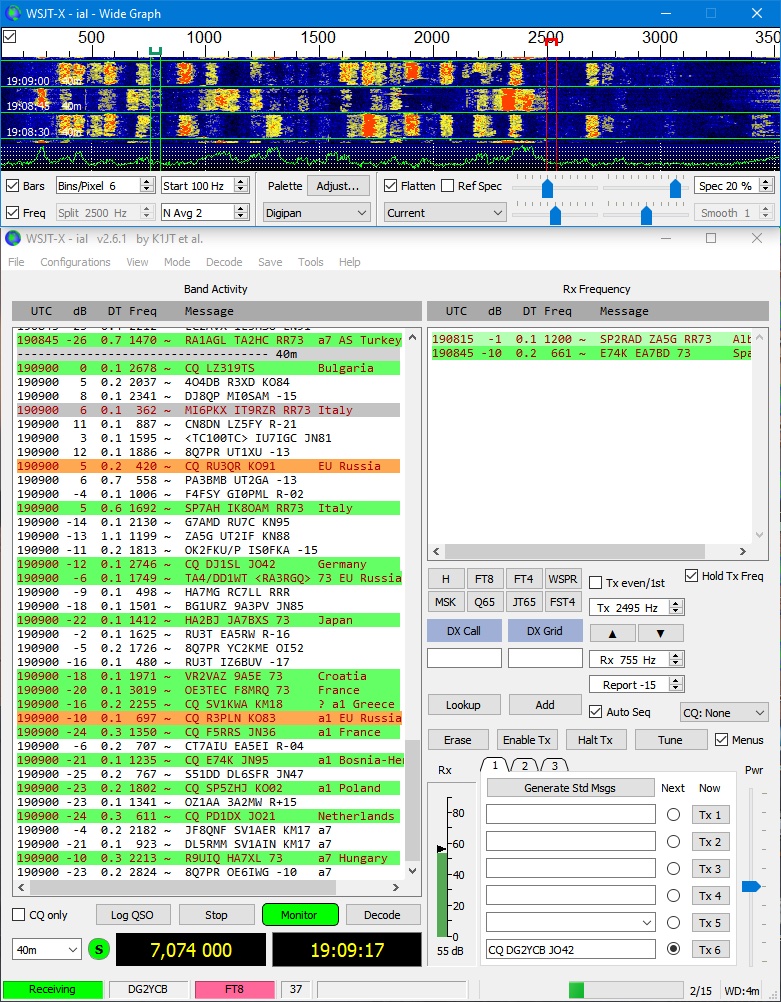Radio
All radios work as long as they are capable of
transmitting on the frequencies you desire. Although, your
radio may put out 100W, for digital communication 50W is plenty.
But beyond that, what else makes a difference.
Sound Card
It’s all about the sound card! Some radios like an
ICOM 7300 have the sound card included in the radio. But
don’t dispair, if your radio does not include it. A popular
option to add this feature to your radio is the
SignaLink USB Digital Communications
Interface from TigerTronics.
If you have a radio similar
to the ICOM 7300, you will need one cable to connect between your
computers USB port and the radio. Do you have a extra printer
cable around? If not, look at your favorite store for
computer supplies or Amazon.
If you don’t, two wires
will be required, a USB cable from computer to sound interface, and
from the sound interface to your radio. Do some research on
your radio and find out the best option available to add this
feature, if your radio doesn’t include a sound
card.
Computer
A computer that runs WSJT
is a key element. What operating system is required?
Although, Windows is the most popular, LINUX and MacOS are also
available. Do you love your Raspberry Pi?
This is also a possibility for you to explore.
Make sure your computer has a USB-C port or convert from
USB-A to USB-C.
If your using a laptop, it
might come with a track pad built in. If you like using it,
great! If you don’t or are using you setup at an event with
mulitlple operators, you might want to bring a
mouse.
Time Synchronization
So what’s this
time synchronization thing? Key element of using the
digital mode is that all the computers using WSJT must
be synchronized. If you are not in sync, it can be
disastrous for you. You will not see anyone using a mode or
no one will respond to you.
Today, computers sync
automatically. So why do I need to add this feature?
As an everyday user, you don’t care if your computer is 3-15
seconds out of sync. It doesn’t bother you and you probably
don’t notice. When using a digital mode, it must be
EXACT!
An example of FT8 is done in 15 second to recieve and to
transmit. If the computer is not in sync with everyone else,
you will reduce or completely miss the timing
window.
If you want to check your clock, goto Time.is website to check that your
clock is on point. The website should respond that your time
is EXACT.
How do I accomplish time synchronization? It
depends if you have internet available in determining the
method you chose.
Internet or
Hotspot availability through cellphone
Great news! If you
have ability to connect to the internet, two popular options are
CronyControl(Mac) or NetTime(Windows)
No
Internet
GPS is the typical solution, when you don’t
have an internet connection. There are various software
applications, both free and paid, that can use a GPS receiver to
sync the system time.
Ready to
Configure The Radio and ComputerOnce your get all these
pieces together, you are ready to configure your radio and WSJT
software! Below are two PDF documents, that will help
you start your configuration for a Windows
machine.
Am I
finished?
Technically, yes.
At this point you can start connecting to others. To excel
at using your prefered digital mode, you will need a few more
things.
Logging Program
Although, WSJT logs your contacts, it does
not connect to eQSL, QRZ, or LOTW. WSJT createstwo of the most popular logging formats,
Cabrello and ADIF formats for you. Some logging programs can
interface directly with WSJT. If your logbook doesn't, you
can load up the ADIF log supplied by WSJT.
If you haven’t chosen the
logbook to use with your ham radio, talk to your local ham radio
club and find out what programs they are using.
GridTracker
GridTracker is a warehouse of amateur radio information presented in an easy to
use interface, from live traffic decodes, logbooks, real-time spot
reports, weather, current solar conditions, and
more. What does this mean to me? It depends on the
objective. Are you looking for a POTA (Parks On The Air), or
looking to make contact in every state or GRID? This tool can
help you find those contacts and what frequencies and modes they
are working on.
PSKReporter
Ever wonder if they can hear you
and what your signal strength being recieved is? Goto https://pskreporter.info/
What can I learn from searching your callsign? It will show
you callsigns that heard your signal, and you can find out the
strength they recieved it.
Want to see if
a specific call sign hears you?Input their callsign into
the query. Goto your location on the map and click on your
callsign to find what they are recieving. This might be
easier then finding their location when you input your callsign
because you might not know exactly where they are transmitting
from.
Operating WSJT and the importance dB field in CQ's
Use dB as a gauge to determine your odds
of the other operator to respond to your answer to his CQ.
The dB that everyone responds to is a judgement call.
Over -15db, you have a good chance of someone responding to you.
Does this mean if the dB is -22 that you won’t get a
response? NO! If you really want that station, give it
a try. You may get lucky! It might be that station that
operates a few times a year and it’s on your bucket
list.
Starting/Stopping Order for Digital Communication is
Important.
After you have all your connections to
your radio, computer, and sound cards, follow these
steps.
- Turn on Radio
- On computer, start your time
syncronization first. If you have this automatically
starting every time you boot, you can ignore this
step.
- Start WSJT
When shutting down do in the reverse order.
- Close WSJT
- Shut off computer
- Shut off radio.
|


